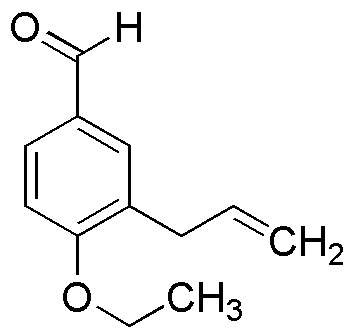3-Allyl-4-ethoxybenzaldehyde is widely utilized in research focused on:
- Flavor and Fragrance Industry: This compound is used as a flavoring agent and fragrance component, providing a unique aroma that enhances food products and perfumes.
- Pharmaceutical Development: It serves as an intermediate in the synthesis of various pharmaceuticals, contributing to the development of new medications with improved efficacy.
- Organic Synthesis: Researchers employ this compound in organic synthesis reactions, particularly in the creation of complex organic molecules, due to its reactive allyl group.
- Material Science: It is explored in the formulation of specialty polymers and resins, offering enhanced properties such as flexibility and durability for various applications.
- Biological Research: The compound is studied for its potential biological activities, including anti-inflammatory and antioxidant properties, paving the way for new therapeutic agents.
General Information
Properties
Safety and Regulations
Applications
3-Allyl-4-ethoxybenzaldehyde is widely utilized in research focused on:
- Flavor and Fragrance Industry: This compound is used as a flavoring agent and fragrance component, providing a unique aroma that enhances food products and perfumes.
- Pharmaceutical Development: It serves as an intermediate in the synthesis of various pharmaceuticals, contributing to the development of new medications with improved efficacy.
- Organic Synthesis: Researchers employ this compound in organic synthesis reactions, particularly in the creation of complex organic molecules, due to its reactive allyl group.
- Material Science: It is explored in the formulation of specialty polymers and resins, offering enhanced properties such as flexibility and durability for various applications.
- Biological Research: The compound is studied for its potential biological activities, including anti-inflammatory and antioxidant properties, paving the way for new therapeutic agents.
Documents
Safety Data Sheets (SDS)
The SDS provides comprehensive safety information on handling, storage, and disposal of the product.
Product Specification (PS)
The PS provides a comprehensive breakdown of the product’s properties, including chemical composition, physical state, purity, and storage requirements. It also details acceptable quality ranges and the product's intended applications.
Certificates of Analysis (COA)
Search for Certificates of Analysis (COA) by entering the products Lot Number. Lot and Batch Numbers can be found on a product’s label following the words ‘Lot’ or ‘Batch’.
*Catalog Number
*Lot Number
Certificates Of Origin (COO)
This COO confirms the country where the product was manufactured, and also details the materials and components used in it and whether it is derived from natural, synthetic, or other specific sources. This certificate may be required for customs, trade, and regulatory compliance.
*Catalog Number
*Lot Number
Safety Data Sheets (SDS)
The SDS provides comprehensive safety information on handling, storage, and disposal of the product.
DownloadProduct Specification (PS)
The PS provides a comprehensive breakdown of the product’s properties, including chemical composition, physical state, purity, and storage requirements. It also details acceptable quality ranges and the product's intended applications.
DownloadCertificates of Analysis (COA)
Search for Certificates of Analysis (COA) by entering the products Lot Number. Lot and Batch Numbers can be found on a product’s label following the words ‘Lot’ or ‘Batch’.
*Catalog Number
*Lot Number
Certificates Of Origin (COO)
This COO confirms the country where the product was manufactured, and also details the materials and components used in it and whether it is derived from natural, synthetic, or other specific sources. This certificate may be required for customs, trade, and regulatory compliance.


